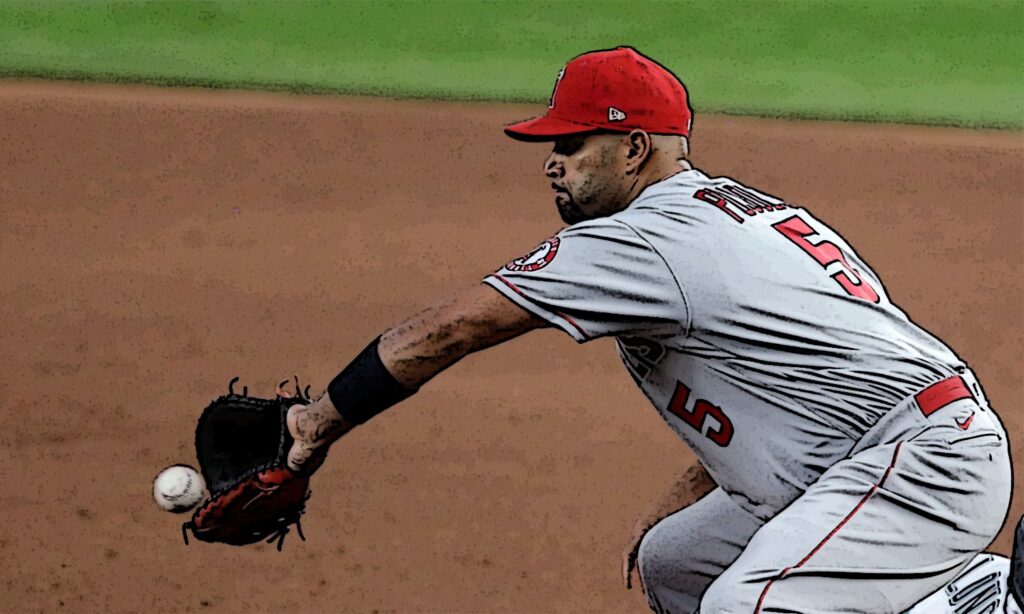One of the most important components of baseball, which is often overlooked by the casual fan, is defensive play.
What may look like monotonous, routine plays by the fielders typically requires tremendous amount of practice.
I’m talking about ground balls, pop flies, double plays, preventing stolen bases and the repetitive pitching and catching throughout each inning.
Occasionally, were rewarded with the diving catches, triple plays or even home run saving robberies by the wall.
All these individual and team defensive efforts are actually monitored by each team and, ultimately, by Major League Baseball.
When defensive players handle the live ball, they are typically credited with an assist or a putout.
The assist is simply the given to the player who helps in getting the batter or baserunner out.
By now, you should have an idea, but let’s answer the question you came here for.
What does PO mean in Baseball?
PO is an acronym for Putout, which is the action taken by a fielding player that results in an out being recorded. The player can record a putout by catching a foul ball, fly ball or line drive, tagging a runner or on a strikeout. Putouts are used to calculate the fielding percentage, which measures the player's defensive efficiency.
If you assumed the putout is rewarded to the pitcher on the strikeout, you’d be wrong.
In fact, the catcher is rewarded with the putout since they are last to grab hold of the ball on the strikeout.
Remember that if the catcher were to mishandle the ball on the strikeout, the batter is permitted to run to first base.
This play is known as a dropped third strike.
Either the catcher regains control of the ball and tags the player out or he must throw the ball to first base for the out.
In the latter case, the player at first would be credited with the putout.
Putouts and Fielding Percentage
The number of Putouts is used to calculate the Fielding Percentage of every player on defense.
The Fielding Percentage is the sum of all Putouts, Assists and Errors by the fielding player.
An assist rewarded to the defender that helps in the putout.
For example, when the short stop recovers a ground ball and throws it to first, the short stop is credited with the assist.
In that same play, the first baseman is credited with the putout.
Obviously, if the first baseman were to drop the ball on the throw, he’d be penalized with an error.
For the most part, first basemen, catchers and fielders tend to have a high overall fielding percentage.
The shortstops, second and third basemen have the lowest overall fielding percentage because plays which involve them are relatively more complex.
Putouts, along with fielding percentage are tallied throughout the season for each player.
The more putouts and assists recorded, the higher your fielding percentage will be. Obviously, you need to keep the errors at a minimum too.
Who has the most Putouts in MLB history?
It’s safe to say that the top 10 players for putouts are a lock-in for the foreseeable future.
The closest active player on the leaderboard is Albert Pujols in 27th place. At the same time, he’s also 43 years old.
When you go further down that list, the only player with any hope is first baseman, Freddie Freeman.
Currently he’s ranked 67th overall and is still relatively young at 33 years old.
But, in reality, he’s barely over halfway to the record holder, Jake Beckley.
The number to catch is 23,743 putouts. Freeman has over 10K to go.
And, just so you know, the leaderboard is peppered with first basemen. They are usually the recipient for the bulk of ground outs.
MLB Career Putout Leaderboard
| Player Name | Putouts | |
|---|---|---|
| 1 | Jake Beckley | 23,767 |
| 2 | Cap Anson | 22,572 |
| 3 | Ed Konetchy | 21,378 |
| 4 | Eddie Murray | 21,265 |
| 5 | Charlie Grimm | 20.722 |
| 6 | Stuffy McInnis | 20,120 |
| 7 | Mickey Vernon | 19,819 |
| 8 | Jake Daubert | 19,634 |
| 9 | Lou Gehrig | 19,525 |
| 10 | Joe Kuhel | 19,386 |
Final Thoughts
Putouts is one of those statistics I wasn’t familiar with growing up watching baseball.
While the concept seems simple, I took these routine plays mostly for granted.
Given that I had experience playing baseball as young boy, I do realize the skill set required to play shortstop and third baseman.
Throwing the ball to first base at lightning speed and pinpoint accuracy to tag the runner is quite impressive.
Try that on a professional size diamond, and the task is even more daunting.
Let’s not forget about the fielder gloving the ball while moving in one direction and having to throw it instantly to the other.
That takes tremendous strength, power, and balance.
And while MLB players are expected to do this every single game, their efforts mostly go unrecognized by the average fan base.
But don’t worry, players are well compensated for these very routine tasks.
In fact, the more they make it look routine, the better they get paid for it.
Let's also give credit to the first basemen. Sometimes they need to make painful stretches and acrobatic moves to secure every putout.






